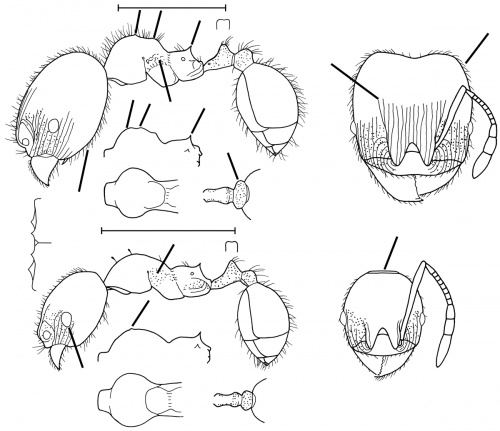Pheidole dinophila
| Pheidole dinophila | |
|---|---|
| Scientific classification | |
| Kingdom: | Animalia |
| Phylum: | Arthropoda |
| Class: | Insecta |
| Order: | Hymenoptera |
| Family: | Formicidae |
| Subfamily: | Myrmicinae |
| Tribe: | Attini |
| Genus: | Pheidole |
| Species: | P. dinophila |
| Binomial name | |
| Pheidole dinophila Wilson, 2003 | |
From Wilson (2003): All of the series at Itirapina and the one at Campo Grande were collected in nests of the giant ponerine ant Dinoponera australis by Ricardo V. S. Paiva and C. Roberto F. Brandão (Paiva, personal communication).
Identification
See the description in the nomenclature section.
Keys including this Species
Distribution
Pheidole dinophila has been collected in the type locality (Mato Grosso do Sul) and far to the east, at Itirapina, near Rio Claro, São Paulo. Another series from Niquelândia, Goiás, has been tentatively placed in dinophila, but differs from the types by the more extensive sculpture and longer propodeal spines of the major and by the absence of spatulate hairs in the minor; and thus may prove to be a distinct species. (Wilson 2003)
Distribution based on Regional Taxon Lists
Neotropical Region: Brazil (type locality).
Distribution based on AntMaps
Distribution based on AntWeb specimens
Check data from AntWeb
Countries Occupied
| Number of countries occupied by this species based on AntWiki Regional Taxon Lists. In general, fewer countries occupied indicates a narrower range, while more countries indicates a more widespread species. |

|
Estimated Abundance
| Relative abundance based on number of AntMaps records per species (this species within the purple bar). Fewer records (to the left) indicates a less abundant/encountered species while more records (to the right) indicates more abundant/encountered species. |

|
Biology
Castes
Nomenclature
The following information is derived from Barry Bolton's Online Catalogue of the Ants of the World.
- dinophila. Pheidole dinophila Wilson, 2003: 408, figs. (s.w.) BRAZIL.
Unless otherwise noted the text for the remainder of this section is reported from the publication that includes the original description.
Description
Similar in various traits to Pheidole alacris, Pheidole atticola, Pheidole hazenae, Pheidole lucaris and Pheidole ulothrix, differing as follows.
Major: central portion of the lateral strip of mesopleuron covered by broken rugulae; remainder of mesopleuron and entire posterior half of head entirely smooth and shiny; pronotum with small convexity visible above its dorsal profile in side view; mesonotal convexity present; pilosity of head dense, short, and of nearly uniform length, in comparison with pilosity on remainder of body; propodeal spines vary from reduced and denticulate to equilaterally triangular; postpetiole from above elliptical.
Minor: mesosomal pilosity very sparse, with hairs on the pronotal dorsum spatulate; eyes large; occiput narrowed, with a thin nuchal collar; humerus in dorsal-oblique view denticulate; a strip across middle of mesopleuron foveolate, and remainder of mesosoma smooth and shiny.
MEASUREMENTS (mm) Holotype major: HW 1.00, HL 1.04, SL 0.64, EL 0.16, PW 0.50. Paratype minor: HW 0.60, HL 0.64, SL 0.58, EL 0.10, PW 0.38.
COLOR Major: body dark reddish brown; appendages medium reddish brown except for light reddish brown antennae and tarsi.
Minor: body medium reddish brown, appendages light reddish brown.
Figure. Upper: holotype, major. Lower: paratype, minor. Scale bars = 1 mm.
Type Material
BRAZIL: 10 km east of Campo Grande, Mato Grosso do Sul, col. Carlos Roberto F. Brandão. Museu de Zoologia da Universidade de Sao Paulo and Museum of Comparative Zoology
Etymology
Gr dinophila, lover (friend) of the terrible, referring to communal life with the giant ant Dinoponera.
References
- Wilson, E. O. 2003. Pheidole in the New World: A dominant, hyperdiverse ant genus. Harvard University Press, Cambridge, MA. (page 408, fig. major, minor described)
- Araujo, E.S., Koch, E.B.A., Delabie, J.H.C., Zeppelini, D., DaRocha, W.D., Castaño-Meneses, G., Mariano, C.S.F. 2019. Diversity of commensals within nests of ants of the genus Neoponera (Hymenoptera: Formicidae: Ponerinae) in Bahia, Brazil. Annales de la Société entomologique de France (N.S.), 1–9. (doi:10.1080/00379271.2019.1629837).
- Dias, A.M., Lattke, J.E. 2021. Large ants are not easy – the taxonomy of Dinoponera Roger (Hymenoptera: Formicidae: Ponerinae). European Journal of Taxonomy 784, 1–66 (doi:10.5852/ejt.2021.784.1603).
